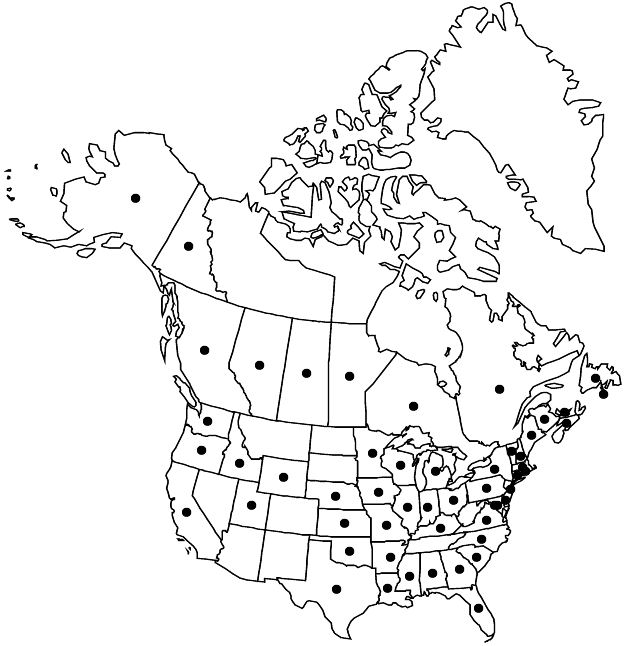Viola tricolor var. tricolor
Plants usually annual, rarely perennial, caulescent, not stoloniferous, 3–45 cm. Stems 1–9, prostrate, decumbent, or erect, simple or branched, subglabrous or puberulent, clustered on taproot. Leaves cauline; stipules palmately lobed or pinnatifid, middle lobe oblanceolate, obovate, elliptic, or lanceolate, sometimes ± equaling leaf blade, margins entire or usually crenate, ciliate, apex acute to obtuse; petiole 1–3.3 cm, glabrous or puberulent; blade ovate to ± oblong (distal blades lanceolate), 1.5–2.8 × 0.8–2.3 cm, base cordate, truncate, or attenuate, margins coarsely crenate-serrate, ciliate or eciliate, apex acute to obtuse, surfaces pubescent abaxially at least on major veins, glabrous adaxially. Peduncles 3–12.5 cm, usually glabrous. Flowers: sepals deltate-lanceolate to linear-lanceolate, margins usually ciliate, auricles 2–4 mm; petals: upper 2 commonly violet, lateral white, and lowest yellow or white on both surfaces with darker yellow patch basally, variants include lateral 2 violet distally or all petals violet, white, yellow, or red, lateral 2 densely bearded, lowest and lateral 2 dark violet- to brownish purple-veined, lateral 2 longer than sepals, lowest 10–15 mm, spur usually yellow to violet, rarely white, elongated, 4–5 mm; style head beardless; cleistogamous flowers absent. Capsules subglobose to ovoid, 6–8 mm, glabrous. Seeds tan, 1.5–2 mm. 2n = 26.
Phenology: Flowering Apr–Sep.
Habitat: Cultivated and waste ground, roadsides, lawns, urban parks
Elevation: 10–1000 m
Distribution

St. Pierre and Miquelon, Alta., B.C., Man., N.B., Nfld. and Labr. (Nfld.), N.S., Ont., P.E.I., Que., Sask., Yukon, Ala., Alaska, Ark., Calif., Conn., Del., D.C., Fla., Ga., Idaho, Ill., Ind., Iowa, Kans., Ky., La., Maine, Md., Mass., Mich., Minn., Miss., Mo., Nebr., N.H., N.J., N.Y., N.C., Ohio, Okla., Oreg., Pa., R.I., S.C., Tex., Utah, Vt., Va., Wash., Wis., Wyo., Europe, Asia (Siberia).
Discussion
Variety tricolor was introduced from Europe and is not vegetatively distinguishable from Viola arvensis. In Europe, the variety is pollinated mainly by long-tongued bees (A. R. Clapham et al. 1987).
Selected References
None.